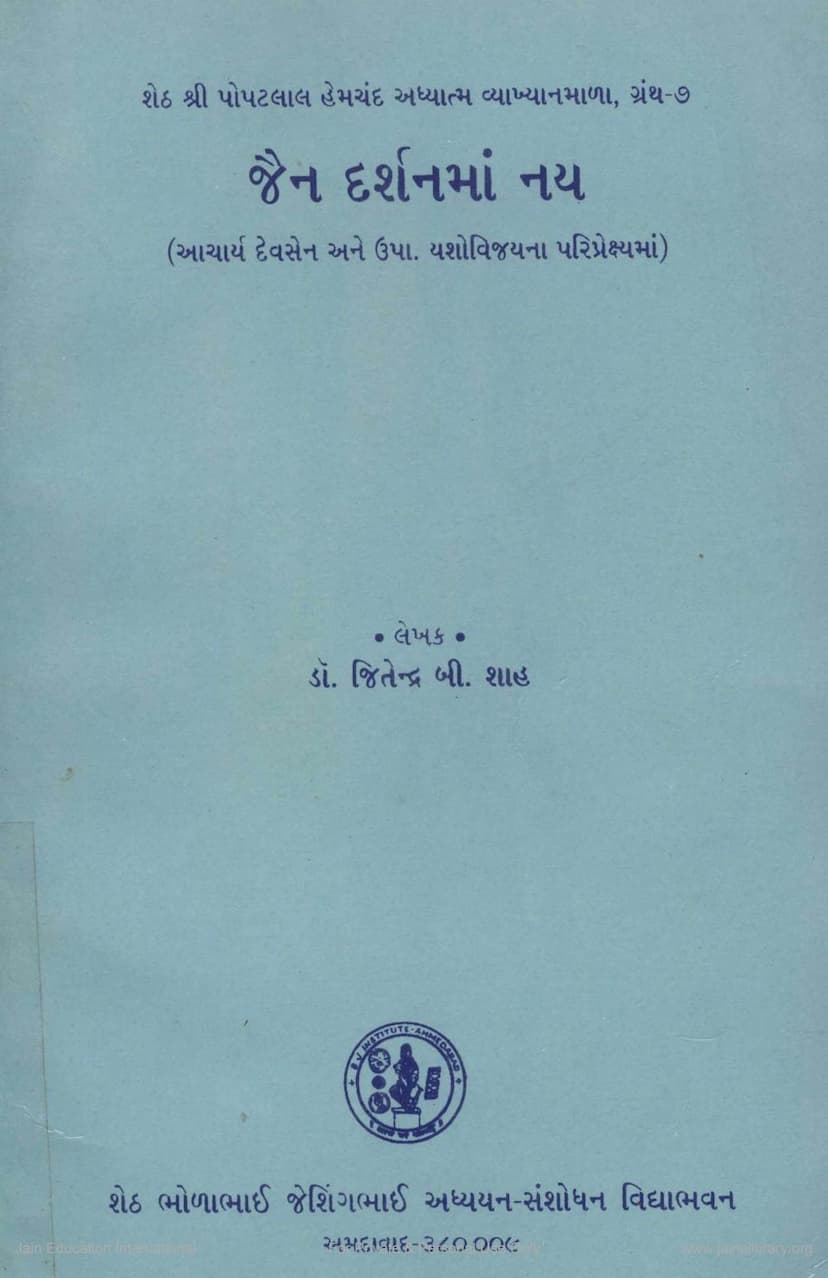Jain Darshnma Nay
Added to library: September 1, 2025

Summary
This document is the first part of a Jain text titled "Jain Darshanamān Naya" (Nay in Jain Philosophy) authored by Dr. Jitendra B. Shah. It is part of the "Seth Shri Popatlal Hemchand Adhyatma Vyashyanmala" series, specifically Volume 7, published by the Seth Bholabhai Jaisinghbhai Adhyayan-Sanshodhan Vidvabhavan in Ahmedabad.
The book focuses on the concept of naya (standpoint or perspective) in Jain philosophy, particularly examining the views of Acharya Devsen and Upadhyaya Yashovijay.
Here's a breakdown of the content presented in these initial pages:
- Title and Author: The book clearly states its title "Jain Darshanamān Naya" and attributes it to Dr. Jitendra B. Shah.
- Series and Publisher: It is part of the "Seth Shri Popatlal Hemchand Adhyatma Vyashyanmala" series, Volume 7, published by the Seth Bholabhai Jaisinghbhai Adhyayan-Sanshodhan Vidvabhavan, Ahmedabad.
- Publication Details: The first edition was published in Vikram Samvat 2058 (2002 CE) with a print run of 500 copies and a price of ₹50.
- Editorial/Preface (Prakashakiya): The Director of the B. J. Vidvabhavan, Dr. Bharti Shelat, expresses pleasure in publishing these lectures by Dr. Jitendra B. Shah. She highlights that Dr. Shah is a renowned scholar of Indian philosophy, especially Jain philosophy. The lectures were delivered on April 26, 27, and 28, 2001, and covered "Jain Darshanma Naya," "Digambaracharya Devsen and his works," and "Naychakra and Dravya-gun-paryay no Ras."
- Introduction (Aamukh): This section delves into the significance of naya in Jain philosophy.
- It defines naya as a "perspective" or "viewpoint" for evaluating a substance or situation.
- The synthesis of all these viewpoints is called syadvada (theory of conditioned predication).
- Understanding naya is crucial for comprehending anekantavada (non-one-sidedness).
- The text mentions that the Agam literature contains extensive thought on naya, which was later philosophically evaluated and logically tested by Jain philosophers like Umasvati, Siddhasen, Pujyapad, and Samantabhadra.
- It highlights Acharya Devsen's significant contribution through his work Nayachakra and Upadhyaya Yashovijayji's critique of it in his Dravya-gun-paryay no Ras.
- The author, Dr. Jitendra B. Shah, expresses his gratitude for the invitation to deliver these lectures and states that the lectures primarily focus on naya, with incidental discussions on the lives of Acharya Devsen and Upadhyaya Yashovijayji.
- The author explains that the second lecture discusses the evolution of thought on naya from the Agamic period to the present day, and the third lecture details the novel style of classifying naya as established by Acharya Devsen.
- The text notes that while Agamic literature mentions 700 nay a, only seven are commonly prevalent. However, Acharya Devsen proposed a new classification with a much larger number of niyo and upanayos, though the scriptural basis for this expanded classification is not clearly established. It also points out that Devsen's classification is prevalent in the Digambar tradition, while the Shvetambar tradition primarily follows the seven naya.
- Table of Contents (Vishaynirdesh): This provides a detailed outline of the book's structure, covering the lives and works of Acharya Devsen and Upadhyaya Yashovijayji, the concept of naya in Jainism, and the analysis of Nayachakra and Dravya-gun-paryay no Ras.
- Detailed Sections: The subsequent pages begin the detailed discussion, starting with the life and works of Acharya Devsen, noting the complexity of identifying a single Devsen due to multiple historical figures with the same name in the Digambar tradition. It then moves on to discussing Devsen's time, sect, guru, scholarly contributions, humility, travels, and his literary works like Darshansara, Aradhana-sara, Tattva-sara, Bhava-sangraha, Naya-chakra, and Alapa-paddhati.
In essence, this initial part of the book serves as an introduction to the topic of naya in Jainism, provides biographical information on key figures like Acharya Devsen and Upadhyaya Yashovijayji, and outlines the scope of the research presented. It establishes the importance of naya as a fundamental principle for understanding Jain philosophy and its multifaceted approach to reality.